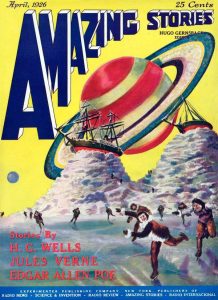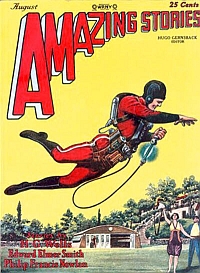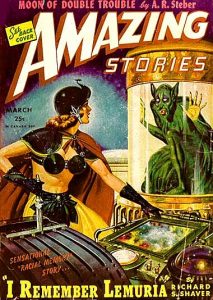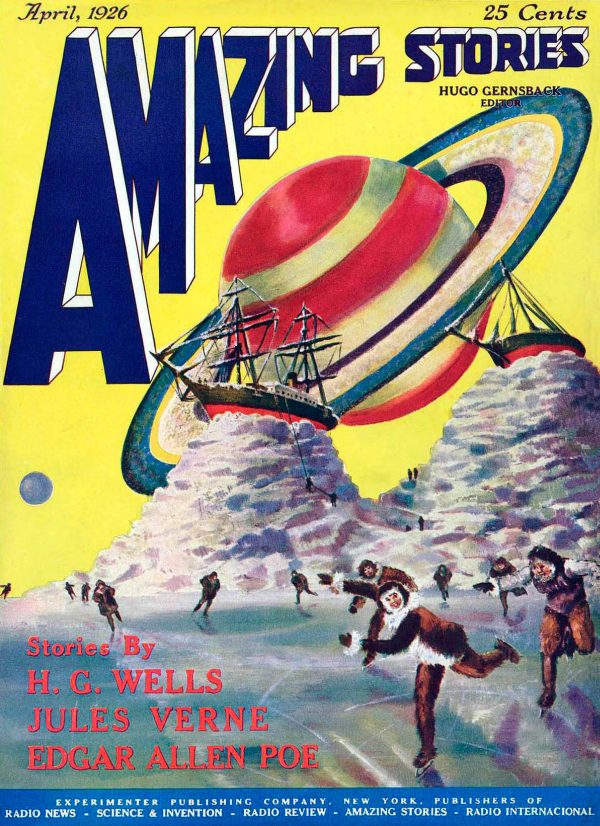 It was hard to miss the first issue of Amazing Stories on the newsstand. Letter-size, larger than the typical pulp magazine, with three-dimensional block letters trailing across its masthead and a bright yellow backdrop that framed an alien landscape and a bright red, ringed planet and small moon, the magazine certainly stood out on the sales rack. Frank R. Paul was the artist.
It was hard to miss the first issue of Amazing Stories on the newsstand. Letter-size, larger than the typical pulp magazine, with three-dimensional block letters trailing across its masthead and a bright yellow backdrop that framed an alien landscape and a bright red, ringed planet and small moon, the magazine certainly stood out on the sales rack. Frank R. Paul was the artist.
The names on the front cover of the magazine’s early issues were also major selling points: Edgar Allan Poe, Jules Verne, H. G. Wells, Garrett P. Serviss, Edgar Rice Burroughs, A. Merritt, and others. It was just as Gernsback wrote in his editorial for the pulp’s first issue: “By ‘scientifiction’ I mean the Jules Verne, H. G. Wells, and Edgar Allan Poe type story—a charming romance intermingled with scientific fact and prophetic vision.” That is what the readers of Amazing Stories sought: “They wanted to be entertained, to escape, to experience that sense of wonder that good visionary fiction brought.” (The Time Machines).
Using stories drawn from the Munsey magazines, Blue Book, The Strand, and other sources, Gernsback offered reprints of science-fiction classics, eventually coupling these with new stories generated through contests. Using such competitions, Gernsback began to acquire a stable of new writers willing and able to write scientifiction: Miles J. Breur, Clare Winger Harris, David H. Keller, S. P. Meek, A. Hyatt Verrill, Harl Vincent, and others. Through his letter column, entitled “Discussions,” he reeled his readers into his world of wonder.
 Within months, the new specialty magazine was selling over 100,000 copies of each issue. In establishing the first specialized science-fiction magazine, Gernsback had tapped a vein of wonder, shared by lonely individuals prone to “imaginative flights of fancy.” Next would come Amazing Stories Annual, published in the summer of 1927 and featuring Edgar Rice Burroughs’ The Mastermind of Mars. Amazing Stories Quarterly followed in the winter of 1928. Then, in the August 1928 number of Amazing Stories, Gernsback introduced his readers to E. E. “Doc” Smith’s “The Skylark of Space” and Philip Francis Nowlan’s “Armageddon—2419 AD,” the first tale to feature Buck Rogers. These two “space operas” would color science fiction for well over a decade, turning it into “that crazy Buck Rogers stuff.”
Within months, the new specialty magazine was selling over 100,000 copies of each issue. In establishing the first specialized science-fiction magazine, Gernsback had tapped a vein of wonder, shared by lonely individuals prone to “imaginative flights of fancy.” Next would come Amazing Stories Annual, published in the summer of 1927 and featuring Edgar Rice Burroughs’ The Mastermind of Mars. Amazing Stories Quarterly followed in the winter of 1928. Then, in the August 1928 number of Amazing Stories, Gernsback introduced his readers to E. E. “Doc” Smith’s “The Skylark of Space” and Philip Francis Nowlan’s “Armageddon—2419 AD,” the first tale to feature Buck Rogers. These two “space operas” would color science fiction for well over a decade, turning it into “that crazy Buck Rogers stuff.”
Despite its seeming success, the Gernsback publishing empire continuously experienced cash flow problems. Plowing money into his radio interests and paying an extremely hefty salary to both himself and his brother, Gernsback offered generally low word rates for stories. Coupled with a slow payment schedule, often months after a story had been published, very few authors were interested in writing for the company. In early 1929, Gernsback’s printer and paper supplier demanded payment on past due bills, leading the publisher to file for bankruptcy. Experimenter Publishing Company, went into receivership, ending Hugo Gernsback’s involvement with the first science-fiction pulp, Amazing Stories.
Hugo Gernsback edited and published Amazing Stories from April 1926 through April 1929. Afterward, T. O’Conor Sloane, who had assisted Gernsback from the start, became the magazine’s editor until the April 1938 issue. Sloane was far from being a visionary; he thought space travel was impossible.
Sloane and Gernsback were also the editors of Amazing Stories Quarterly. The latter helmed the magazine from Winter 1928 through Spring 1929. Sloane edited the magazine from Summer 1929 through Fall 1934, its final issue. Later quarterlies, published by Ziff-Davis, were rebound issues of Amazing Stories and not a separate magazine.
 Ziff-Davis took over the magazine with its April 1938 number and Ray Palmer as editor. The new editor turned Amazing Stories into a juvenile magazine, establishing a stable of authors to write fiction aimed at the youth market. Toward the end of his editorial reign, Palmer started “The Shaver Mystery,” a hoax involving an evil race that causes all of mankind’s problems from their home in underground caverns. Palmer’s last issue was dated December 1949. In later years, he became involved with UFOs and similar topics, publishing Fate magazine.
Ziff-Davis took over the magazine with its April 1938 number and Ray Palmer as editor. The new editor turned Amazing Stories into a juvenile magazine, establishing a stable of authors to write fiction aimed at the youth market. Toward the end of his editorial reign, Palmer started “The Shaver Mystery,” a hoax involving an evil race that causes all of mankind’s problems from their home in underground caverns. Palmer’s last issue was dated December 1949. In later years, he became involved with UFOs and similar topics, publishing Fate magazine.
Howard Browne, a Palmer assistant, assumed the editorship in January 1950. Primarily interested in mystery fiction, Browne nevertheless turned Amazing Stories around, directing it toward an adult audience. It became a digest magazine with its April/May 1953 issue. Browne left the magazine following its August 1956 number. He was succeeded by Paul Fairman and the talented Cele Goldsmith. Ms. Goldsmith managed the magazine from March 1957 through June 1965, during which time it garnered a great deal of respect.
The Ultimate Publishing company, headed by Sol Cohen, began publishing the magazine with its August 1965 issue. Joseph Wrzos was its first editor, followed by Harry Harrison, Barry Malzberg, Ted White, and Elinor Mavor. The magazine was acquired by TSR Hobbies in March 1982, with Mavor temporarily serving as editor. George Scithers became the editor with the November 1982 issue. Later editors included Patrick Price, Kim Mohan, and Jeff Berkwits. Its last issue was published in March 2005 with Paizo Publishing in charge.
In July 2012, longtime science-fiction fan Steve Davidson revived Amazing Stories as an online magazine. You can find it at http://amazingstoriesmag.com/.
From 1985-1987, NBC television ran an anthology series called Amazing Stories. It was created by Steven Spielberg.
To learn more about the images used in this post, click on the illustrations. Click here for references consulted for this article.







